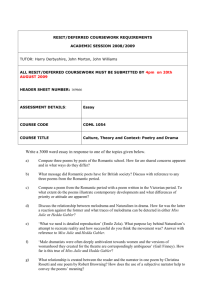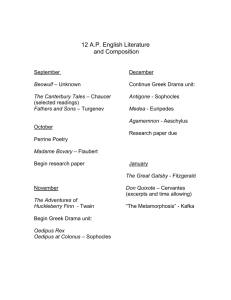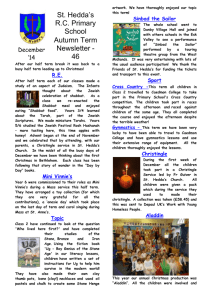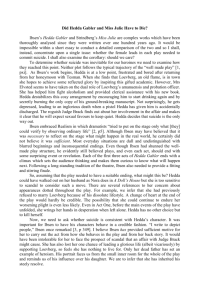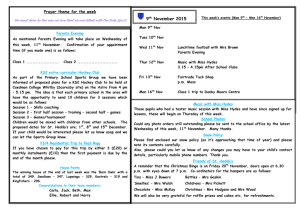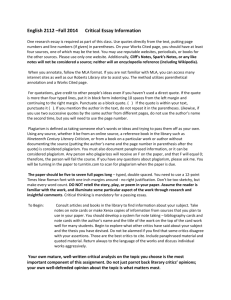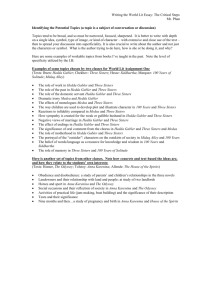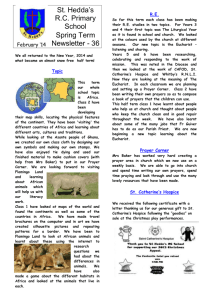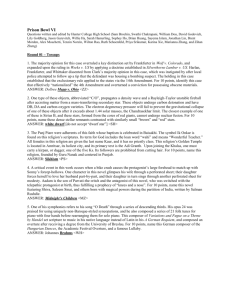Writing on a play: Henrik Ibsen's Hedda Gabler
advertisement
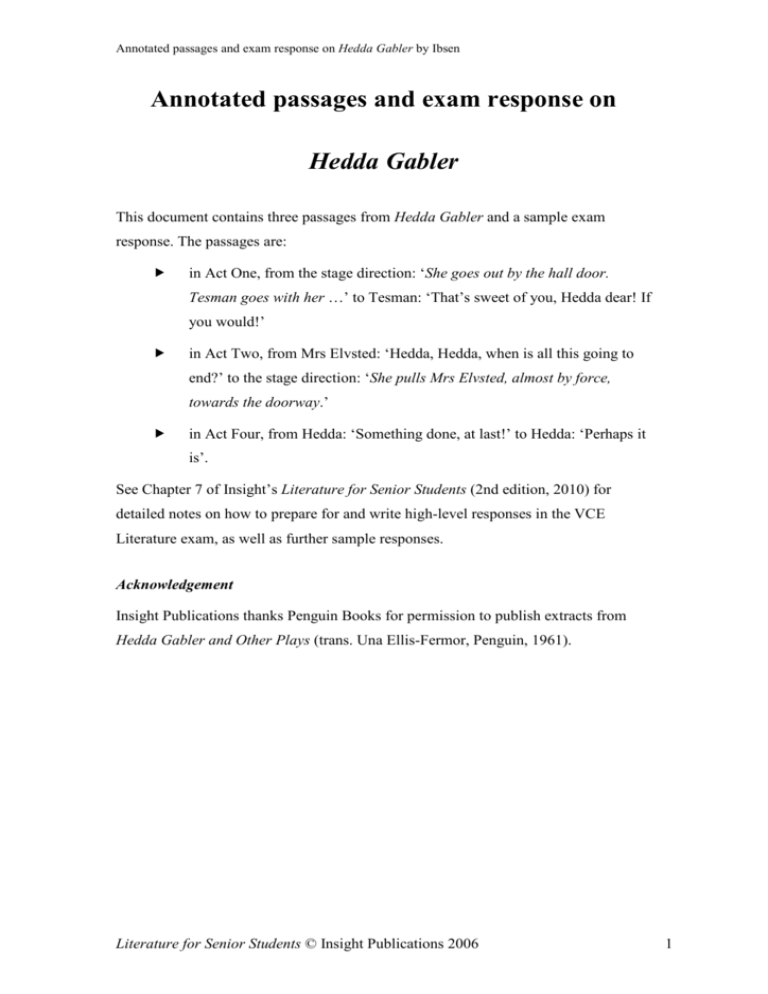
Annotated passages and exam response on Hedda Gabler by Ibsen Annotated passages and exam response on Hedda Gabler This document contains three passages from Hedda Gabler and a sample exam response. The passages are: in Act One, from the stage direction: ‘She goes out by the hall door. Tesman goes with her …’ to Tesman: ‘That’s sweet of you, Hedda dear! If you would!’ in Act Two, from Mrs Elvsted: ‘Hedda, Hedda, when is all this going to end?’ to the stage direction: ‘She pulls Mrs Elvsted, almost by force, towards the doorway.’ in Act Four, from Hedda: ‘Something done, at last!’ to Hedda: ‘Perhaps it is’. See Chapter 7 of Insight’s Literature for Senior Students (2nd edition, 2010) for detailed notes on how to prepare for and write high-level responses in the VCE Literature exam, as well as further sample responses. Acknowledgement Insight Publications thanks Penguin Books for permission to publish extracts from Hedda Gabler and Other Plays (trans. Una Ellis-Fermor, Penguin, 1961). Literature for Senior Students © Insight Publications 2006 1 Annotated passages and exam response on Hedda Gabler by Ibsen The passages The annotations show some of the key elements and features of the passages that could be drawn on in a response. 1. [She goes out by the hall door. Tesman goes with her, leaving the door half open. He can be heard repeating his messages to Aunt Rina and thanking her for the shoes. In the meanwhile Hedda crosses the room, raising her arms and clenching her hands, as if in fury. Then she pulls back the curtains from the glass door and stands there looking out. After a moment Tesman comes in again, shutting the door behind him.] TESMAN [picking up the slippers from the floor]. What are you looking at, Hedda? HEDDA [calm and controlled again]. I’m just looking at the Very detailed and significant stage direction: Hedda expresses her feelings physically rather than verbally. Note the important role of the set: the glass door could be seen as symbolic of the social and material barriers that keep Hedda unhappily inside the domestic realm. leaves. They’re so yellow, and so withered. TESMAN [wrapping up the shoes and putting them on the table]. Well, after all, we’re well on in September now. Language use – repetition of ‘in’ and ‘September’ draws attention to the significance of this month: it signifies not merely a time of year, but a phase of life at the beginning of a decline from youthful vigour and optimism. HEDDA [disturbed again]. Yes, just think. We’re already in – in September. TESMAN. Don’t you think Aunt Julle was rather unlike herself, my dear? A little bit – almost formal? Whatever do you think was the matter? Eh? HEDDA. I hardly know her, you see. Isn’t she like that as a rule? TESMAN. No, not like she was today. Characterisation: Tesman is portrayed as methodical, orderly, and not very perceptive – he seems oblivious to Hedda’s mood and does not quite grasp the sources of the tension between Hedda and Aunt Julle. HEDDA [moving away from the glass door]. Do you think she was really upset about that business with the hat? TESMAN. Oh, not much. Perhaps a little, just at the moment. HEDDA. But what extraordinary manners! To throw her hat down here in the drawing-room. One doesn’t do that kind of thing. TESMAN. Well, you can be sure Aunt Julle won’t do it again. HEDDA. Anyway, I’ll make it all right with her. Narrative structure: ‘One doesn’t do …’ – anticipates the last words of the play (spoken by Brack in response to Hedda’s suicide). TESMAN. That’s sweet of you, Hedda dear! If you would! Literature for Senior Students © Insight Publications 2006 2 Annotated passages and exam response on Hedda Gabler by Ibsen 2. MRS ELVSTED [who has got up and is wandering restlessly Very unusual image: conveys Hedda’s romantic and unconventional view of Lövborg. Also reflects her longing for relief from her orderly, predictable existence – for the wild rather than the domesticated. This links with her looking out the glass door in passage 1; also links with notion of ‘beauty’ in passage 3. about the room]. Hedda, Hedda, where is all this going to end? HEDDA. Ten o’clock – then he will come. I can see him. With vineleaves in his hair. Flushed and confident. MRS ELVSTED. Yes, if only it would be like that. HEDDA. And then, you see, then he’ll have got control of himself again. Then he will be a free man for the rest of his days. MRS ELVSTED. Heavens, yes. If only he would come like that. As you see him. HEDDA. He’ll come like that – ‘so and no otherwise’. [Getting up and going nearer.] Go on doubting him as long as you like. I believe in him. And now we’ll try … MRS ELVSTED. There’s something behind all this, Hedda. Central idea: Hedda’s desire for power, which is related to how powerless she feels – and perhaps to her aristocratic background. Stage direction: Mrs Elvsted’s movements reflect and convey her agitated state of mind. HEDDA. True; there is. I want, for once in my life, to have Language use: ‘a free man’ is an odd expression here – what does it mean in the context of the play? Is anyone really ‘free’ in this society? The idea of freedom could link/contrast with Hedda’s sense of entrapment in passage 1. power over a human being’s fate. MRS ELVSTED. But haven’t you got that? HEDDA. I have not. And never have had. MRS ELVSTED. Not over your husband’s? HEDDA. That would be worth having, wouldn’t it? Ah, if you could only realise how poor I am. And here are you, offered such riches! [Throwing her arms passionately round her.] I think I shall burn your hair off, after all. MRS ELVSTED. Let go! Let go! I’m frightened of you, Hedda! BERTE [in the doorway between the rooms]. Tea’s laid in the dining-room, ma’am. HEDDA. Good. We’re coming. Hedda sees herself as poor not due to material wants but emotional wants: this suggests a set of values quite different from those of her family and friends. Of course, Hedda’s material wants are largely satisfied – so how sympathetically are we asked to view Hedda at this point? MRS ELVSTED. No, no, no! I’d rather go home alone. At once! Language use – Hedda’s use of the diminutive ‘little goose’ – and the following stage direction convey Hedda’s power over Mrs Elvsted, expressed both verbally and physically. HEDDA. Nonsense! You must have tea first, you little goose. And then, at ten o’clock, Ejlert Lövborg will come – with vineleaves in his hair. [She pulls Mrs Elvsted, almost by force, towards the doorway.] Literature for Senior Students © Insight Publications 2006 3 Annotated passages and exam response on Hedda Gabler by Ibsen Characterisation through what Hedda says and how she says it (tone indicated by stage direction). Hedda’s inappropriate response to Lövborg’s death reflects her boredom with her monotonous existence, but also displays her lack of compassion and sympathy. 3. HEDDA [in a ringing voice]. Something done, at last! TESMAN [horrified]. Good heavens! What are you saying, Hedda? HEDDA. That there is an element of beauty in this. BRACK. Hm. Mrs Tesman – TESMAN. Of beauty! Fancy that! MRS ELVSTED. Oh, Hedda, how can you talk of beauty in a thing like that! Language use: ‘beauty’ is a very unusual word to use in this situation, and draws our attention to the strange way in which Hedda views other people. Also, beauty is valued by Hedda – whereas the others attach little or no importance to it. HEDDA. Ejlert Lövborg has balanced his account with himself. He has had the courage to do … what had to be done. MRS ELVSTED. No, don’t ever believe that it happened in that way. What he has done was done in a moment of madness. TESMAN. Done in despair. HEDDA. It was not. Of that I am certain. MRS ELVSTED. Yes, it was. In a moment of madness. Just as when he tore up our manuscript. BRACK [in surprise]. Manuscript? The book, do you mean? Has he torn that up? MRS ELVSTED. Yes, he did it last night. Characterisation: Tesman acknowledges to Hedda that he is complicit in the actions that have led to Lövborg’s death, yet he shows no real remorse; his instincts are for self-preservation, not for justice – the text does not endorse his values any more than it does Hedda’s. Tesman and Mrs Elvsted cannot understand Hedda, showing their very different sets of values. Hedda rationalises Lövborg’s ‘suicide’, whereas the others view suicide as inherently irrational. TESMAN [whispering softly]. Oh, Hedda, we shall never get clear of this business. BRACK. Hm. That was odd. TESMAN [walking about the room]. Fancy Ejlert going out of the world like that! And not even leaving behind him the book that would have made his name immortal. Narrative structure: Hedda’s remark anticipates her own suicide. Language use: repetition of ‘a moment of madness’ reflects Mrs Elvsted’s desire to excuse the man she had loved. Moreover, the repetition draws our attention to the role of madness in the play: who might really be considered to be acting with ‘madness’? Perhaps it is Hedda’s actions that are best viewed in this light? MRS ELVSTED. Oh, if only it could be put together again! TESMAN. Yes, just think if it could! I don’t know what I wouldn’t give – MRS ELVSTED. Perhaps it can, Mr Tesman. TESMAN. What do you mean? MRS ELVSTED [looking in her handbag]. Look here. I have kept the loose notes that he used for dictating from. HEDDA [a step nearer]. Ah! TESMAN. You’ve kept them, Mrs Elvsted! Eh? MRS ELVSTED. Yes, I have them here. I took them with me when I came away, and here they’ve been, lying in my handbag. Characterisation: Mrs Elvsted is reliable and rational; she devises a practical plan of action. Here she is not intimidated by Hedda – contrast with passage 2. TESMAN. Just let me see them! Literature for Senior Students © Insight Publications 2006 4 Annotated passages and exam response on Hedda Gabler by Ibsen MRS ELVSTED [passes him a stack of small sheets]. But they’re in such a muddle. All mixed up together. TESMAN. Fancy, if we could get it straight, though! Perhaps if we help each other – Characterisation: Hedda’s scepticism shows both her accurate knowledge of, and disdain for, her husband. It is also ironic: she is the one who will ‘give her life’. MRS ELVSTED. Oh yes! Let’s try, at any rate! TESMAN. It shall be done! It must! I will give my life to this. HEDDA. You, Jörgen? Your life? TESMAN. Yes. Or, rather, all my spare time. My own stuff must wait for the present. You understand, Hedda? Eh? It’s something I owe to Ejlert’s memory. HEDDA. Perhaps it is. Literature for Senior Students © Insight Publications 2006 Language use: a very interesting expression – ‘All mixed up together’ could also apply to the characters’ intertwined relationships. As the sheets are sorted, so are relationships realigned: Tesman and Mrs Elvsted; Hedda and Brack. Characterisation: the project appeals to Tesman’s methodical nature – link with passage 1; perhaps his sense of guilt is also involved? 5 Annotated passages and exam response on Hedda Gabler by Ibsen Sample response The comments preceding each paragraph of this essay outline the writer’s approach, so that the generic qualities of the answer are identified. They also indicate the ways in which the assessment criteria are addressed; italicised words and phrases are key terms in the examination criteria. (Go to www.vcaa.vic.edu.au for the criteria, or see Literature for Senior Students, 2nd edition, pp.201–2.) Introduction The response opens with a quotation from the third passage, which signals one of the main concerns to be discussed: Hedda’s interest in beauty. This is linked to several other aspects of the play – Hedda’s social context, her sense of entrapment and limitation, the characters’ responses to Lövborg’s death – connections which can be further explored in the body paragraphs. The paragraph ends with a views and values comment. ‘… there is an element of beauty in this.’ Throughout Hedda Gabler, Hedda longs for a moment, or a vision, of beauty that will break the tedious monotony of existence – that will render life stimulating and provocative, rather than an endless series of meaningless moments. Yet beauty always lies just beyond Hedda’s grasp. She thinks, however perversely, that she glimpses it in Lövborg’s presumed suicide; Lövborg’s death, though, is in fact a sordid and messy affair, quite remote in reality from Hedda’s romantic vision. Marriage, domestic life and middle-class society all fail to satisfy – indeed, they intensify – Hedda’s longing for transcendence. Moreover, her friends and family do not share or understand her vision: for Mrs Elvsted, Lövborg’s suicide can only be comprehended as the result of ‘a moment of madness’. Ultimately, our view of Hedda is of a tormented character, trapped by her material and social circumstances but also by her own distorted perspective, which prevents her from experiencing any compassion for or understanding of those around her. Literature for Senior Students © Insight Publications 2006 6 Annotated passages and exam response on Hedda Gabler by Ibsen Paragraph 2 Material from passage 1, including the detailed stage direction that begins it, is used to develop the discussion of Hedda’s longing for freedom/feeling of being trapped. This indicates a link between the passages as well as allowing the discussion to develop coherently. Language use, setting and characterisation are features of the text used to develop the interpretation. Hedda’s yearning to be free is a sign both of the limitations of her life and of the complex nature of her own personality. Throughout the play we see her standing at thresholds – looking through the glass doors, pausing at doorways – as if she longs to leave but is unwilling to abandon the safety and relative security of her home. As she talks to her husband she looks through the glass doors at the autumn foliage; yet, rather than finding the leaves a source of beauty, she sees them as signs of death and decay, ‘so yellow, and so withered’. If her interior, domestic setting offers few opportunities for pleasure, the outside world is even less inviting to Hedda. The changing leaves seem to remind her of the inexorable passage of time in her own life; summer has passed and winter approaches, just as her own youthful freedoms have been left behind. The word ‘September’ is repeated by Hedda, making its metaphorical significance as a marker of change clearer both to herself and to the audience. Hedda’s frustration is also evident in her actions as she stands at the window, ‘raising her arms and clenching her hands, as if in fury’. She contains her emotion, just as she feels contained within a world she has no desire to remain in, but cannot bring herself to leave. Reference to stage directions to support assertions about Hedda’s psychological state. Language use (repetition) is discussed and its effect and meaning explained. Paragraph 3 The response moves to a more thorough discussion of the views and values presented by the play, in relation to the social context it depicts. Tesman and Mrs Elvsted are considered as embodying aspects of their social class, which the play subtly critiques through their contrast with the more dynamic Hedda. Passage 2 is drawn on for the discussion of Mrs Elvsted. Just as the everyday thresholds of doors and windows signal Hedda’s frustrations and yearnings, they also symbolise the mundane ordinariness of suburban middle- Literature for Senior Students © Insight Publications 2006 7 Annotated passages and exam response on Hedda Gabler by Ibsen Gives a sense of the playwright crafting the text for certain effects and responses. class society, which Ibsen’s late plays so often hold up to scrutiny. It is not so much that Ibsen seeks to strongly condemn the conventions and attitudes of this social class, as to expose the many ways in which they limit both the behaviour and the imaginations of those within it. Tesman and Mrs Elvsted are exemplary members of their social context: they cultivate respectability, quietness, conscientiousness and moderation. Of these qualities, only the first is also desired by Hedda – the others are diametrically opposed to the kind of life Hedda aspires to lead. A more complex side to Mrs Elvsted’s personality is suggested by the fact that she has left a loveless marriage and her children; she is not, it seems, entirely willing to live without passion. Her emotional commitment to Lövborg – ‘I believe in him’ – and her willingness to share Hedda’s vision of Lövborg with ‘vineleaves in his hair’ also indicate a romantic dimension to her personality. However, this scene between Hedda and Mrs Elvsted ends by marking the differences, rather than the similarities, between them. Hedda is strong and dominating – ‘throwing her arms passionately’ around the younger woman and cajoling her with the diminutive ‘little goose’; Mrs Elvsted, though ‘frightened’, submits meekly to Hedda’s demands. Paragraph 4 The discussion of Ibsen’s treatment of middle-class views and values continues from the previous paragraph, with a shift in focus to Tesman and to evidence from passage 3. What finally draws Mrs Elvsted and Tesman together is their shared excitement at the prospect of restoring Lövborg’s manuscript and their pleasure at being able to ‘help each other’. It is companionship, after all, that is most desirable to them both. The project is worthy, but effectively concedes that the creative vision of a dead man is greater than their own. As Tesman suggests, it comprises a kind of memorial ‘to Ejlert’s memory’, and such a goal is entirely consistent with Tesman’s world view: he prefers to consolidate and preserve an object from the past rather than create something entirely new and unpredictable in the future. In this way, the narrowness of Tesman’s outlook – which is also, by extension, that of the social class whose values he exemplifies – is exposed: its focus is inward rather than outward; it attends Literature for Senior Students © Insight Publications 2006 Use of textual detail (direct quotes). Discusses the text’s wider view of the social group being depicted. 8 Annotated passages and exam response on Hedda Gabler by Ibsen methodically to the fine details, but lacks the vision to comprehensively grasp the wider picture. Paragraph 5 This paragraph continues the analysis of passage 3. The discussion of how this passage anticipates the tragic ending addresses the structure of the play, and explains why this key passage contributes to an interpretation of the text as a whole. The contrast between the perspectives of Hedda and Tesman is nowhere more evident than when she challenges his declaration that he will ‘give [his] life to this’. Hedda would never say such a thing without meaning to accomplish it literally, but she knows that Tesman is incapable of acting in this way. Tesman admits that his statement is merely a rhetorical flourish, a commitment that will amount to no more than spending his ‘spare time’ on reconstructing Lövborg’s book. In contrast, Hedda imagines the devotion of one’s life to a grand cause as heroic and uplifting, prefiguring her own actions at the end of the play. Her words for Lövborg’s death – at least while she still thinks of it as a suicide – convey her admiration for such a sacrifice: she regards it as containing an ‘element of beauty’ and displaying great ‘courage’, neither of which qualities she associates with her husband. However, the more openly Hedda shows her disdain for Tesman, the more marginalised and isolated she becomes in her own home. Her romantic idealism is regarded sceptically by both Mrs Elvsted and Tesman, who propose ‘madness’ or ‘despair’ as much more rational explanations for Lövborg’s actions. Indeed, Hedda increasingly appears prone to her own ‘moment[s] of madness’; her perverse exclamation ‘Something done, at last!’ in ‘a ringing voice’ when she learns of Lövborg’s death reveals how distorted her perspective has become – and how little she has come to value life. Moves back in to close reference to passage 3 to support the argument that Hedda is increasingly marginalised. Paragraph 6 – conclusion The conclusion draws together the various concerns of the discussion, including the idea of thresholds, Hedda’s feeling of being contained and her yearning for beauty and transcendence. It refers to the end of the play in order to generate a sense of closure and to affirm the dual sense that Hedda is both victim of her circumstances Literature for Senior Students © Insight Publications 2006 9 Annotated passages and exam response on Hedda Gabler by Ibsen and responsible for her own destiny – consolidating the interpretation developed throughout. Like Lövborg’s death, Hedda’s suicide is less an act of courage than ‘done in despair’, the result of a kind of ‘madness’ in which life is regarded as having less intrinsic value than death. She is trapped in circumstances she has little capacity to change; she yearns to cross a threshold into freedom, but knows that the only physical thresholds available to her are the doorways of her own house, beyond which there are few prospects for an improved situation. As limiting as her circumstances are, Hedda’s longing for ideas and experiences that transcend the everyday further exacerbates her sense of entrapment. Finally, the only beauty she can imagine is the pure, unchanging state of death; Hedda is driven to take her own life in an effort not merely to be free, but to create her tragic vision of ‘beauty’ in a scene completely of her own making. It is also – and this is perhaps the real tragedy of Hedda Gabler – a vision that no one among her family or friends is able, or even desires, to share or understand. Literature for Senior Students © Insight Publications 2006 Opening sentence of conclusion links with ideas and quotes from previous paragraph to ensure continuity. Links back to material from introduction and second paragraph. 10 Annotated passages and exam response on Hedda Gabler by Ibsen Assessor comments This response shows a perceptive understanding of the text and develops a plausible, detailed and coherent interpretation through reference to the set passages. The argument unfolds logically throughout the response. The writing is expressive and sophisticated; vocabulary such as ‘rhetorical flourish’, ‘exacerbates’ and ‘transcendence’ allows complex ideas to be expressed succinctly. The response makes good use of textual details from the passages to support the interpretation, integrating quotations smoothly and eloquently. The discussion shows an understanding of how views and values are aligned with particular characters who are contrasted and/or linked, and of how the text presents a viewpoint, which is sometimes complex, on these characters. Features of the text such as characterisation, structure and aspects of staging and performance are analysed in terms of how they contribute to the play’s meaning. Stage directions are discussed in addition to dialogue, showing an awareness of the text’s form and audience. The response would receive an A to A+ grade. Literature for Senior Students © Insight Publications 2006 11
